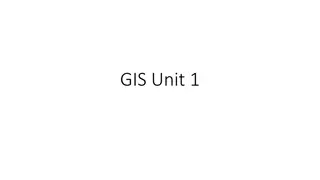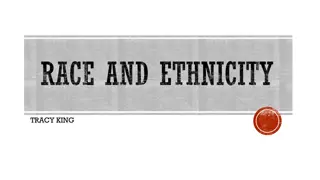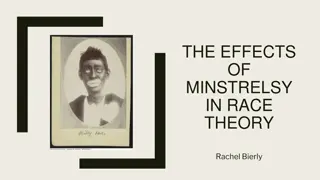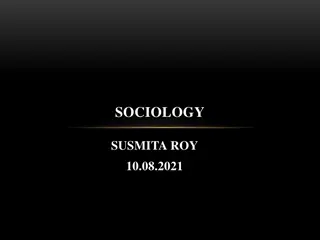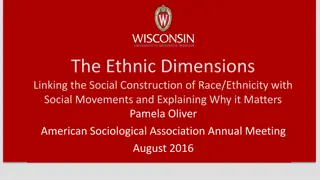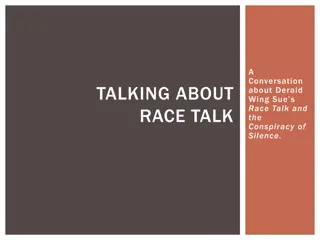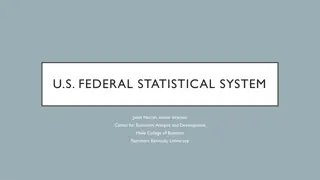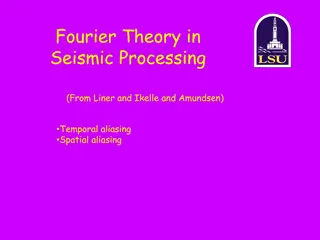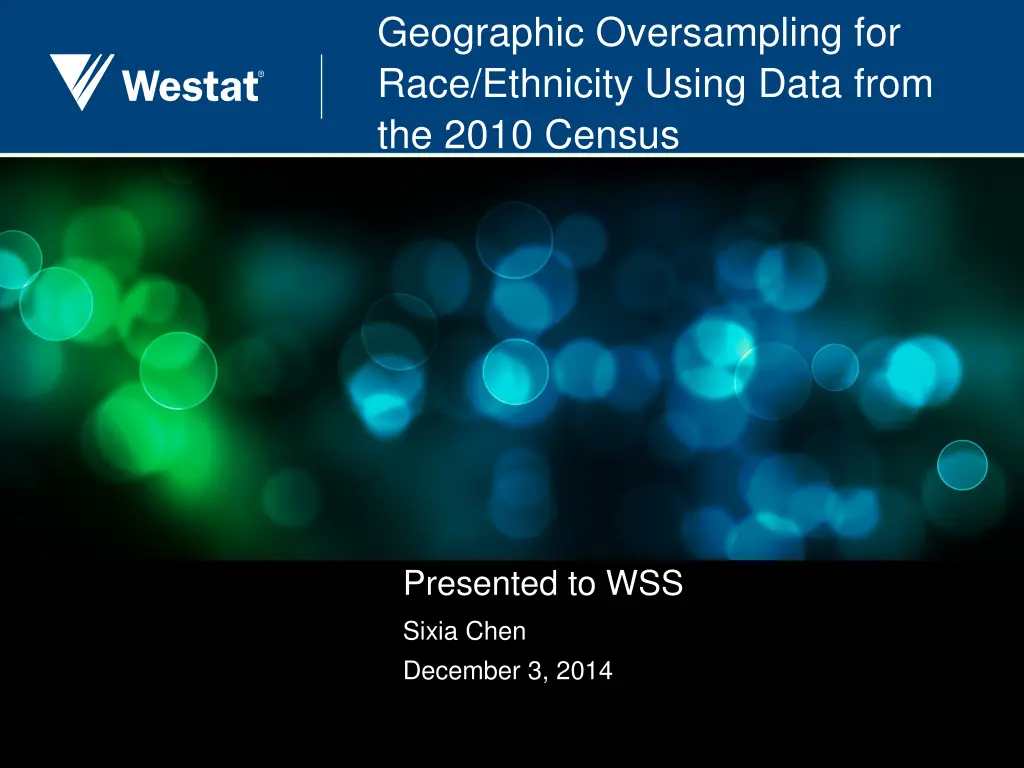
Geographic Oversampling for Race/Ethnicity Study Using Census Data
Explore the use of geographic oversampling for race/ethnicity studies based on Census data. Learn about survey characteristics, sampling approaches, theoretical results, and underlying assumptions. Discover how oversampling can enhance data accuracy for diverse populations.
Download Presentation

Please find below an Image/Link to download the presentation.
The content on the website is provided AS IS for your information and personal use only. It may not be sold, licensed, or shared on other websites without obtaining consent from the author. If you encounter any issues during the download, it is possible that the publisher has removed the file from their server.
You are allowed to download the files provided on this website for personal or commercial use, subject to the condition that they are used lawfully. All files are the property of their respective owners.
The content on the website is provided AS IS for your information and personal use only. It may not be sold, licensed, or shared on other websites without obtaining consent from the author.
E N D
Presentation Transcript
Geographic Oversampling for Race/Ethnicity Using Data from the 2010 Census Presented to WSS Sixia Chen December 3, 2014
Overview A number of surveys are carried out to study the characteristics of specific race/ethnicity domains: 2011-2014 National Health and Nutrition Examination Survey (NHANES): Blacks, Hispanics and Asians. 2014 Minnesota Survey on Adult Substance Use (MNSASU): Blacks, Asians, American Indians and Hispanics. 2013-2014 California Health Interview Survey (CHIS): Latinos, Vietnamese, Koreans, and American Indians/Alaska Natives. 2
Overview (cont.) Various sampling approaches for sampling minorities: Oversample strata defined by the geographic areas where the minority is more concentrated, such as 2014 MNSASU. Oversample by surnames (sometimes first names also) for Asians and Hispanics, such as 2010 CHIS, 2014 MNSASU. Location sampling has been used for sampling Brazilians of Japanese descent. Others (e.g., respondent driven sampling) 3
Geographic Oversampling This presentation focus on geographic oversampling. Waksberg, Judkins, and Massey (1997) evaluated the effectiveness of geographic oversampling based on data from the 1990 Census. This presentation updates the Waksberg et al. results using the 2010 Census, and extends the results to subdivisions of the country and oversampling multiple minorities simultaneously. 4
Outline Basic theoretical results. Comparisons of the effectiveness of geographic oversampling in 1990 and 2010 at the national level for Blacks, Hispanics, Asians, and American Indians/Alaska Natives (AI/AN). An investigation of different cut-points of minority prevalence in forming the strata. Application of the approach to Census regions and to Core Based Statistical Areas (CBSAs) and non-CBSAs. Some approaches for oversampling multiple domains. Limitations and conclusions. 5
Underlying Assumptions Assumptions made: Simple random sampling is used in each stratum. The parameter to be estimated is a population mean for the minority ?. The population element variances are the same in all strata. Limitations: No clustering. The main results considered focus on estimates for a single minority. They do not handle oversampling of a minority as part of a general population survey. 6
Theoretical Results (Kalton and Anderson, 1986) The optimum sampling fraction in density stratum ? for a fixed overall budget is ?? ?? ??? ? +? where ?? is the prevalence of the minority in stratum ? and ? is the ratio of the cost of a full interview to the cost of a screening interview. When ? = ?, this result reduces to ?? ?? . 7
Theoretical Results (cont.) The variance reduction % with optimum sampling fractions rather than equal sampling fractions is ???? ? ? ? ??? ? ?+?? ? ? ?+?? ?? = ? ? ?+? ? where ??is the proportion of the minority population in stratum ?, ?? is the proportion of the total population in stratum ?, ? = ????? is the prevalence of the minority in the total population. 8
Theoretical Results (cont.) When ? = ?, ???= ? [ ? (????))]?. ???is the maximum reduction that can be achieved. The formula for ???shows that oversampling of higher density strata will be effective to the extent that the distributions of ??and ?? across the strata are different. In practice generally ? > ? and often markedly so, so that the effectiveness of oversampling will be much smaller than ???. 9
Effectiveness of Oversampling in 1990 and 2010 The results presented are for density strata based on minority densities in (1) Census blocks and (2) Census block groups (BGs). For comparability the same density strata definitions are used for both years. The 1990 Census question asked for only a single race, whereas the 2010 question allowed for multiple races. The 2010 results reported here are for those who responded only the specified race (e.g., Blacks alone). 10
Effectiveness of Oversampling in 1990 and 2010 (cont.) The numbers of block was about 25 percent larger in 2010 than in 1990 whereas the number of block groups declined slightly. The Hispanic and Asian minorities are far more prevalent in 2010 than they were in 1990. The comparative results are for single race and all ages; later results are for a given race for adults aged 18 and over. 11
Clustering of Blacks by Blocks, 1990 and 2010 Percent of total population (??) 1990 77 10 5 8 100 Percent of Blacks (??) Density stratum (??) 1990 9 14 16 61 100 2010 11 21 22 47 100 2010 72 15 6 7 100 <10% 10%-30% 30%-60% 30%-60% Total Blacks as % of total population 12 13 12
Clustering of Hispanics by Blocks in 1990 and 2010 Percent of total population (??) 1990 69 10 11 5 4 100 Percent of Hispanics (??) Density stratum (??) 1990 7 8 22 23 40 100 2010 4 6 22 26 43 100 2010 48 14 20 10 9 100 <5% 5%-10% 10%-30% 30%-60% 60%-100% Total Hispanic as % of total population 9 16 13
Clustering of Asians1 by Blocks, 1990 and 2010 Percent of total population (??) 1990 85 7 6 1 1 100 Percent of Asians (??) Density stratum (??) 1990 19 18 32 18 13 100 2010 13 15 36 24 12 100 2010 75 11 10 3 1 100 <5% 5%-10% 10%-30% 30%-60% 60%-100% Total Asians as % of total population 3 5 1Asians, Native Hawaiians, and other Pacific Islanders 14
Clustering of AI/AN by Blocks, 1990 and 2010 Percent of AI/AN (??) 1990 34 12 16 8 30 100 Percent of total population (??) 1990 98 1 1 0 0 100 Density stratum (??) 2010 39 14 17 7 23 100 2010 97 2 1 0 0 100 <5% 5%-10% 10%-30% 30%-60% 60%-100% Total AI/AN as % of total population 1 1 15
Percentage variance reduction achieved by oversampling by block and by block group (???%) Minority 1990 Block 2010 Block 1990 BG 2010 BG Black 53 44 45 36 Hispanic 51 39 43 31 Asian 47 45 36 33 AI/AN 52 45 39 29 16
Values of ??% achieved by oversampling for different values of ?, 2010 block data (all ages, single race) Cost ratio: ? Black Hispanic Asian AI/AN 1 44 39 45 45 3 29 24 37 41 5 21 17 31 38 10 12 9 22 33 20 6 4 13 26 30 4 3 9 21 17
Values of ???% for the original, cumulative root frequency, and optimal stratification, 2010 block data (aged 18+, multi-race) Minority Original Optimal Cum ? 42 47 47 Black 40 40 40 Hispanic 42 42 42 Asian 32 31 32 AI/AN 22 23 Rented housing 18
Values of ???% in subpopulations with optimal stratification, 2010 block data Black 47 47 55 40 35 45 71 Hispanic 40 40 45 41 25 39 61 Asian 42 40 41 37 34 41 49 AI/AN 32 17 35 32 31 27 64 National Northeast Midwest South West CBSA Non-CBSA 19
Clustering of Blacks in Non-CBSAs, 2010 Block Data Density stratum <5% 5%-10% 10%-25% 25%-50% 50%-100% Total Blacks as % non- CBSA population Percent of Blacks 3 3 9 17 68 100 Percent of total population 82 4 4 4 7 100 8 20
Values of ???% without major strata, with Region and CBSA as major strata, with optimal geographic stratification using 2010 block data Strata Black 47 44 Hispanic 40 35 Asian 42 37 AI/AN 32 31 None Region CBSA/non- CBSA Region X Density CBSA/non-CBSA X Density 46 39 41 32 47 40 42 33 47 40 43 32 21
Estimating Parameters for Multiple Domains Example: Blacks and Hispanics with the same required effective sample sizes, based on 2010 census blocks. The effective sample size for each domain is given by: ?? ?(???/???) (Waksberg et al., 1997). The approaches considered are readily applied for different domains, multiple domains, and differing effective sample sizes by domain. ?? ????= ? ?? = 22
Simple Random Sampling (SRS) Under this equal probability design, the effective sample size is equal to the actual sample size for both domains. Select a screening sample of the size needed to produce the desired sample size for the rarer of the two domains (Blacks in this case). Sample all members of the rarer domain, but sample only a fraction of the less rare domain (the remainder receiving only the screening interview). 23
Combined Density Stratification (CDS) Construct separate sets of five strata for Blacks and Hispanics, using optimum stratification. Cross-classify these strata into 25 cells which are then taken as the final strata. Compute sampling fractions within each of the final strata, together with the effective sample size requirement, for each domain separately. Apply the higher of the two domain sampling fractions in each of the final strata. Include all those sampled from the rarer domain in the sample, but retain only a fraction of the sample in the other domain. 24
Weighted Density Stratification (WDS) Compute a density index, motivated by the composite measure of size for PPS sampling (Folsom et al.,1987), for block j as ??= ? ???+ ???+ ??? where ? = ??/?? with ???, ??? and ??? as the numbers of Blacks, Hispanics, and all other race/ethnicities in block j, respectively Form density strata by applying the cumulative ? rule to this weighted index. Within strata, use the same sampling procedure as for the CDS method. ? ???+ ??? 25
Nonlinear Programming Method (NLP) Construct 25 density strata as for the CDS method. Allocate the sample to these strata using a non-linear programming algorithm that minimizes the overall cost ? = ?????? ??,?? + ??,?? + (? ??,? ??,?) subject to the constraints imposed by the specified effective sample sizes for the domains. 26
Percentage cost reduction compared with SRS by geographic oversampling using the three alternative methods for different values of c DDS 27 13 8 4 1 1 WDS 33 17 11 5 2 1 NLP 37 20 13 7 3 2 Cost ratio, c 1 3 5 10 20 30 27
Values of ???% by geographic oversampling using the three alternative methods Method Blacks Hispanics DDS 27 15 WDS 33 23 NLP 37 27 Single domain 47 40 28
Limitations The variance reductions will be lower later in the decade (Waksberg et al.,1997). The multiple domain approaches are work in progress. Further research is needed in this area. The basic theory assumes a single stage sample with SRS within the density strata. There is a need to consider complex sample designs. See Clark (2009). 29
Conclusions Geographic oversampling remains a useful method for sampling minority populations, although the gains are smaller than they were in 1990. The variance reductions do vary by region and are particularly large for all minorities in non-CBSAs. The choice of cut-points seems be fairly robust to departures from the optimum cut-points. Stratification by region and by CBSA/non-CBSA do not add much benefit after oversampling minorities. The NLP method performed the best of the three approaches for oversampling more than one minority. 30
References Clark, R. G. (2009). Sampling of subpopulations in two- stage surveys. Statistics in Medicine, 28, 3697 3717. Folsom, R.E., Potter, F.J. and Williams, S.K. (1987). Notes on a composite size measure for self-weighting samples in multiple domains. Proceedings of the Section on Survey Research Methods, ASA, 792-796. Kalton, G. and Anderson, D. W. (1986). Sampling rare populations. Journal of the Royal Statistical Society, A, 149, 65-82. Waksberg, J., Judkins, D. and Massey, J.T. (1997). Geographic-based oversampling in demographic surveys of the United States. Survey Methodology, 23, 61-71. 31
Thank You sixiachen@westat.com 32

![❤[PDF]⚡ Escaping from Eden: Does Genesis Teach that the Human Race was Created](/thumb/21697/pdf-escaping-from-eden-does-genesis-teach-that-the-human-race-was-created.jpg)


